Frenchie’s ‘new bistro’ recipes
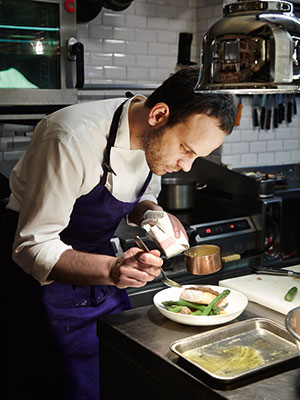
Simply sign up to the Life & Arts myFT Digest -- delivered directly to your inbox.
Gregory Marchand has made a little street in Paris come alive. Rue du Nil, a cobbled passage in the Sentier district, is now home to his restaurant, Frenchie, his wine bar Frenchie Bar à Vins, and Frenchie to Go, a “greasy-spoon-cum-deli” that cures its own bacon, bakes its own bagels and makes sticky-toffee buns from heaven. Now his fishmonger, butcher and vegetable suppliers have set up shop here too, while his coffee supplier has secured a lease opposite the takeaway.
When Marchand first set up Frenchie in 2009, the street was very quiet, he says, and friends advised him against it. With foresight, and his modest seed capital of €10,000, he ignored their advice and secured his 24-cover restaurant site. “I took the leap – and never did I imagine that it would create so much fuss.”
Marchand, who christened his restaurant after the nickname Jamie Oliver gave him when he worked at Fifteen in London, wanted to make food that “reflected his travels”. The upshot is “new bistro” cooking that is polished but never overladen with ideas. What next? London maybe, with an outpost of his wine bar being considered for 2015. Watch out, the Frenchies are coming…
Recipes extracted from ‘Frenchie: New Bistro Cooking’ by Greg Marchand, published by Artisan Press (£16.99)
See Five of the best: Paris hang-outs
——————————————-
Roasted carrot, orange and avocado salad
Serves four
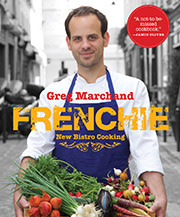
Wine pairing: Touraine white (Sauvignon Blanc); Jean-François Mérieau
This is a dish I could eat every day. Simple, quick and delicious, it combines the crunchiness and sweetness of carrots, the zing of orange and the meaty texture of avocado.
For the roasted carrots
450g baby carrots
¼ tsp coriander seeds
¼ tsp fennel seeds
1 sprig thyme
1 clove garlic, crushed
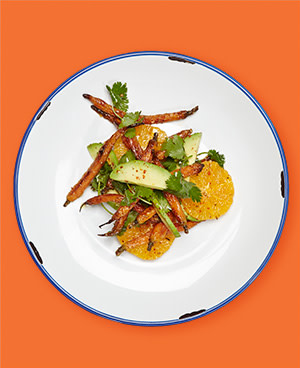
Olive oil
Salt
For the salad
2 to 3 navel oranges (peeled,sliced and pith removed)
2 avocados (cut in thick slices)
3 sprigs coriander
Juice of a lime, or to taste
Olive oil
Fleur de sel
Piment d’Espelette
The roasted carrots
● Preheat the oven to 180C. Trim the carrots and put them in a bowl. Toast the coriander and fennel seeds in a small, dry skillet over medium heat until fragrant (about three minutes) taking care not to burn them. Let them cool, then coarsely crush the seeds with a mortar and pestle or under a heavy skillet. Add the toasted spices to the carrots, along with the thyme, garlic, a drizzle of olive oil and a pinch of salt, and toss well with your hands. Transfer the carrots to a baking dish and roast for 20 to 25 minutes, until tender and lightly browned. Set aside.
To serve
● Combine the carrots, oranges and avocados in a medium bowl. Sprinkle with the coriander, lime juice, olive oil, fleur de sel and a pinch of piment d’Espelette and toss gently. Arrange on salad plates and serve.
——————————————-
Wild garlic broth with fresh crabmeat
Serves four
Wine pairing: Savoie white (Altesse); Adrien Berlioz
This starter combines the subtle bitterness of fragrant citrons with the sweetness of crabmeat and the delicacy of blanched wild garlic leaves. Wild garlic is a plant that grows all over Europe, particularly England; for me, it is the symbol of springtime. Ramps, available in North America in farmers’ markets and gourmet shops, make a good substitute. At Frenchie’s, we prepare this soup using live snow crabs, and if you can get fresh Dungeness, blue or other crabs (about 1 ⅓ lb in the shell), do try their meat in the broth.
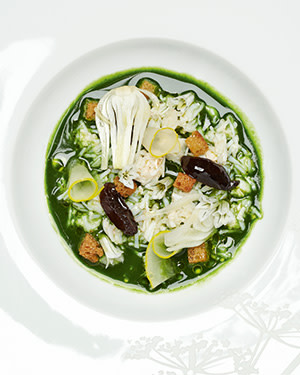
200g crabmeat, preferably jumbo lump
For the wild garlic broth
225g wild garlic leaves or ramps
1 cup baby spinach leaves
Salt
Piment d’Espelette
For the garnish
2 large slices sourdough bread
20g unsalted butter
1 sprig thyme
1 clove garlic, crushed
12 kalamata olives
1 small citron or lemon
1 spring onion
Handful of dill, chervil and tarragon leaves
½ juice of lemon, or to taste
Extra virgin olive oil
Fleur de sel
The crab
● Remove any bits of shell or cartilage from the crabmeat, taking care to leave it in large pieces. Refrigerate.
The wild garlic broth
● Bring a large pot of salted water to a rapid boil. Add the wild garlic leaves, bring back to a boil and cook for 30 seconds, then add the spinach and cook for 10 more seconds. Drain in a strainer set over a bowl, then transfer to a bowl of ice water to cool. Reserve about two cups of the cooking liquid.
● Drain the greens and gently squeeze the leaves to remove as much liquid as possible. Transfer to a blender and purée, adding about 1½ cups of the reserved cooking liquid, or enough to achieve a broth consistency. Season with salt and piment d’Espelette. Refrigerate.
The garnish
● Dice the bread into half-inch cubes. Melt the butter in a small skillet over a medium heat. Add the thyme, garlic and bread and sauté until the croutons are golden brown (about 10 minutes). Drain on a paper towel. Halve and pit the olives. Finely dice the citron, discarding the seeds (or grate the zest of the lemon). Peel and trim the spring onion and cut it lengthwise into very thin slices.
Finishing touches
● Roughly chop the dill, chervil and tarragon leaves. Bring the broth to a simmer in a saucepan. Toss the crabmeat with the lemon juice in another small saucepan, add a drizzle of olive oil and heat gently. Add the herbs and season to taste with fleur de sel. Pour the broth into four bowls, add a spoonful of crabmeat to each one and garnish with the croutons, olives, diced citron (or zest) and onion slices.
——————————————-
Crispy pollack and asparagus with vin jaune sauce and walnut pesto
Serves four
Wine pairing: Côtes du Jura (Savagnin); Jean-François Ganevat
Vin jaune is a dry wine with notes of walnut, apple and curry. Here, the walnut pesto echoes those notes, resulting in a powerful marriage that carries the delicate flavours of the fish and the asparagus. If necessary, vin jaune can be replaced by a fino sherry.
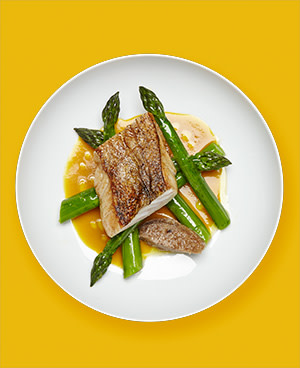
For the vin jaune sauce
2 garlic cloves
2 shallots
2 tbsp unsalted butter
Pinch of curry powder
Small pinch of saffron threads
150ml vin jaune (Savagnin) or fino sherry
½ juice of lime, or to taste
Walnut oil
Salt
For the walnut pesto
½ cup walnut halves
Sunflower oil
½ juice of lemon, or to taste
Fine sea salt
For the asparagus
340g asparagus
Coarse sea salt
Olive oil
For the pollack
4 skin-on pollack (haddock or hake) fillets, about 120g each
Salt
Olive oil
20g unsalted butter
1 sprig thyme
1 clove garlic, crushed
½ bunch chives, finely chopped
The vin jaune sauce
● Peel and finely chop the garlic and shallots. Melt one tablespoon of the butter in a small saucepan over a low heat (keep the remaining butter refrigerated). Add the garlic and shallots and cook, without browning, until softened (about five minutes). Add the curry and saffron and cook for about two minutes. Deglaze the pan with the wine, bring to a boil and reduce by one-third. Transfer to a blender and blend until puréed, then add the lime juice, the remaining butter, cut into small cubes, and a drizzle of walnut oil. Season with a pinch of salt and more lime juice and/or walnut oil and set aside.
The walnut pesto
● Put the walnuts in a blender and grind them, drizzling in about two tablespoons sunflower oil, to a coarse purée. Season with the lemon juice and salt. Set aside.
The asparagus
● Cut off the bottoms of the asparagus on a diagonal. Bring a large pot of salted water to a boil. Add the asparagus, bring back to a boil and cook for two minutes. Drain well, transfer to a sauté pan, and drizzle with olive oil. Set aside.
The pollock
● Season the fish with salt. Heat a large non-stick frying pan over high heat. Add a drop of olive oil and place the fish skin-side down in the hot pan. Cook over medium heat for one to three minutes, depending on the thickness of the fish, until you can see the sides beginning to turn opaque. Add the butter, thyme and garlic and foam the butter, then turn the fish over (the skin should be brown and crispy) and cook, basting with the butter, for one to two minutes, until just cooked through. Drain on a paper towel.
Finishing touches
● Add the chives to the vin jaune sauce and gently reheat, without letting it boil. Warm the asparagus. Place a spoonful of walnut pesto in the centre of four shallow bowls and arrange the asparagus on top. Spoon the sauce over and top with the pollack. Serve immediately.
——————————————-
Pork braised in milk with marinated fennel
Serves four
Wine pairing: Burgundy white (Viognier); Condrieu Georges Vernay
Pork shoulder is one of my favourite cuts: it is full of collagen, which will soften and melt during the long, slow cooking and make the meat tender and tasty. This is an Italian-inspired dish, using techniques I learnt at The River Café in London. The milk proteins also help soften the pork, and then the curds are served with the meat.
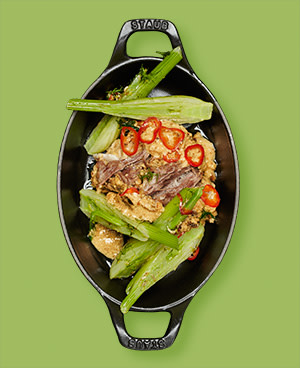
For the pork
11kg boneless pork shoulder roast
Salt and freshly ground black pepper
6 sprigs sage
1 lemon
2 salt-packed anchovies (or 4oil-packed anchovy fillets)
Grapeseed oil
14g unsalted butter
½ clove garlic, crushed
1.25 litres whole milk
For the marinated fennel
6 baby or 3 medium fennel bulbs
1 small chilli pepper
¼ bunch dill
Salt
1½ tsp fennel seeds
1 lemon, grated zest and juice
Olive oil
Coarse sea salt
The pork
● Preheat the oven to 180C. Season the pork shoulder with salt and pepper. Set aside. Tie the sage sprigs together with string.
● With a peeler, remove the zest from the lemon in strips, avoiding the pith. If using salt-packed anchovies, rinse under cold water and remove the two fillets from each one. Heat a large Dutch oven over medium-high heat. Add a drizzle of grapeseed oil and then add the pork, fat-side down. Brown on all sides (three to four minutes per side) then transfer it to a plate.
● Pour off the fat from the pot, put it back over medium heat, add the butter and deglaze the pot with a wooden spoon, scraping up all the meaty browned bits. When the butter starts to foam, add the sage, garlic, anchovies and zest and cook over low heat, stirring, until the anchovies dissolve.
● Add the pork shoulder and pour in enough milk to come about halfway up the sides of the meat. Bring to a simmer, cover with the lid and cook for 2½ to three hours, turning the meat every 30 minutes and adding milk as needed, until the pork is tender and separates easily and the milk has reduced and curdled. If the pork is cooked but the milk has not reduced and curdled, remove the meat from the pot, place the pot over medium heat and cook until the milk has reduced. Then return the pork and cover.
The marinated fennel
● Meanwhile, bring a medium pot of water to a boil. Trim the fennel bulbs, halve lengthwise and cut each half into three wedges. Cut the chilli pepper lengthwise in half, remove the seeds and finely mince the pepper. Chop the dill.
● Salt the boiling water, throw in the fennel seeds and add the fennel wedges. Cook for six to nine minutes; the fennel should be tender but still have a crunch. Drain the fennel pieces and put in a baking dish in a single layer. Cool for a few minutes, then add the chilli pepper, dill and zest. Add lemon juice, drizzle with olive oil and toss gently with your hands. Season with salt to taste.
To serve
● With a large spoon, separate the pork into chunks and divide among four plates. Top with a spoonful of milk curds and arrange the fennel wedges alongside. The pork is best served just slightly warm.
——————————————-
Bittersweet chocolate and wild strawberry tart
Serves eight
Wine pairing: Red Pineau des Charentes; Domaine Château de Beaulon or a good sherry
Wild strawberries (fraises des bois) are a delicacy that form a magical alliance with the intensity of the bittersweet chocolate. If you cannot find them, choose the smallest, most fragrant strawberries at your farmers’ market.
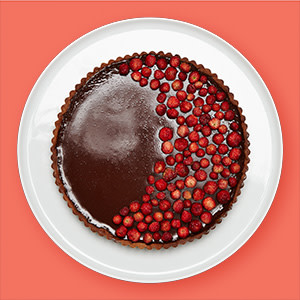
Equipment
1 10in fluted tart pan with a removable bottom
Dried beans or pie weights
For the sweet tart dough
110g cold unsalted butter
175g all-purpose flour
65g pastry or cake flour
25g almond flour (finely ground almonds)
70g icing sugar
1 ½ tsp fine sea salt
1 large egg, at room temperature
1 egg, beaten, for egg wash
For the chocolate filling
170g 70% bittersweet chocolate
235ml heavy cream
120ml whole milk
2 tbsp granulated sugar
1 small egg
For the garnish
225g wild strawberries
Fleur de sel
Olive oil
The dough
● Cut the butter into small pieces. Whisk the flours, almond flour, sugar and salt together in a medium bowl. With your fingertips, work in the butter until the texture is sandy. Quickly beat the egg with a fork in a small bowl, then add to the butter mixture and mix with your hands until the dough just comes together. Flatten the dough into a disk, wrap in plastic wrap and chill for two hours.
● Put the dough on a large sheet of plastic wrap or waxed paper, cover it with another sheet, and roll it into a 12-inch circle. Lift off the top sheet of plastic wrap and carefully invert the dough into the tart pan. Lift off the second sheet and gently press the dough into the bottom and up the sides of the pan, then cut off the excess by running the rolling pin over the edge. (The dough is fragile, but any tears can be patched easily.) Chill for 30 minutes to one hour.
The tart shell
● Preheat the oven to 160C. Cut out a parchment paper circle and line the tart shell with the parchment. Fill with dried beans or pie weights and bake for 20 minutes. Remove the beans and paper and bake for five more minutes. Brush the tart shell all over with the egg wash. Bake for five to seven minutes longer, until golden brown. Let cool to room temperature. Reduce oven to 150C.
The chocolate filling
● Finely chop the chocolate and put it in a bowl. Combine the cream, milk and sugar in a medium saucepan and bring to a boil, stirring to dissolve the sugar.
● Pour the boiling liquid over the chopped chocolate and let stand for 30 seconds, then mix with a rubber spatula until the mixture is smooth. Let cool to lukewarm, then mix in the egg.
● Pour the filling into the baked tart shell and bake for 25 to 30 minutes. The tart is done when the filling is just set. If you shake the pan gently, the chocolate mass should move in one block. Let the tart cool to room temperature on a rack – do not put in the fridge! – and serve it on the day it is made.
Finishing touches
● Unmould the tart. Arrange the strawberries on top (if using bigger ones, cut into halves or quarters). Sprinkle with fleur de sel and add a dash of olive oil.
——————————————-
To comment on this article please post below, or email magazineletters@ft.com
Comments